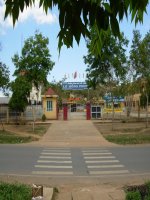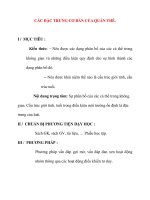CAC DAC TRUNG CO BAN CUA QUAN THE SINH VAT
Bạn đang xem bản rút gọn của tài liệu. Xem và tải ngay bản đầy đủ của tài liệu tại đây (653.76 KB, 19 trang )
<span class='text_page_counter'>(1)</span>Bài 37. Các đặc trng cơ bản cña quÇn thÓ.
<span class='text_page_counter'>(2)</span> Ö l Tû iíi G nh tÝ. Tỉ n h lệ tu óm ổi. §Æc trng c¬ b¶n cña quÇn thÓ. Ët M độ. ©n Ó h p th ù S c¸ bè.
<span class='text_page_counter'>(3)</span> TØ lÖ vÒ giíi tÝnh.
<span class='text_page_counter'>(4)</span> Nhãm tuæi.
<span class='text_page_counter'>(5)</span> Th¸p tuæi d¹ng ph¸t triÓn EARLY. Each successive age group (from 0 - 4 to 85 +) is smaller than the preceding age group. The working age population (shown in orange) has to provide for a mparatively large population of children.However, children can help their parentsin growing food, collecting firewood.
<span class='text_page_counter'>(6)</span> Tháp tuổi dạng ổn định •. INTERMEDIATE. The age pyramid is dominated by the working age groups. Given appropriate conditions (low unemployment etc.) the working age population is potentially well able to support the old and the young. Notice here and in the followingdiagram the left-right asymmetry. This is because women tend to live longer than men.
<span class='text_page_counter'>(7)</span> Th¸p tuæi d¹ng gi¶m sót • LATE. Now the pyramid is almost rectangular in shape. The working age population needs to support a large population of older people.
<span class='text_page_counter'>(8)</span>
<span class='text_page_counter'>(9)</span> ý nghĩa của việc khai thác đúng độ tuổi.
<span class='text_page_counter'>(10)</span> th¸p tuæi ë mét sè níc.
<span class='text_page_counter'>(11)</span> Th¸p tuæi cña ph¸p.
<span class='text_page_counter'>(12)</span> Th¸p tuæi cña Ethiopia.
<span class='text_page_counter'>(13)</span> KÕ hoÆch ph¸t triÓn d©n sè ¬ Ethiopia.
<span class='text_page_counter'>(14)</span> TØ lÖ d©n sè bÞ AIDS ë Nam Ch©u Phi.
<span class='text_page_counter'>(15)</span> Rừng Cà ổi ( phần sườn đồi) hỗn giao với Thông (phần đỉnh đồi) và Cáng Lò (phần chân đồi) tại Trung Quốc. Ph©n bè theo nhãm.
<span class='text_page_counter'>(16)</span> Phân bố ngẫu nhiên cây gỗ.
<span class='text_page_counter'>(17)</span> Phân bố ngẫu nhiênở rừng cúc phương.
<span class='text_page_counter'>(18)</span> Mật độ cá thể của quần thể.
<span class='text_page_counter'>(19)</span> Ảnh hởng của mật độ cá thể.
<span class='text_page_counter'>(20)</span>









